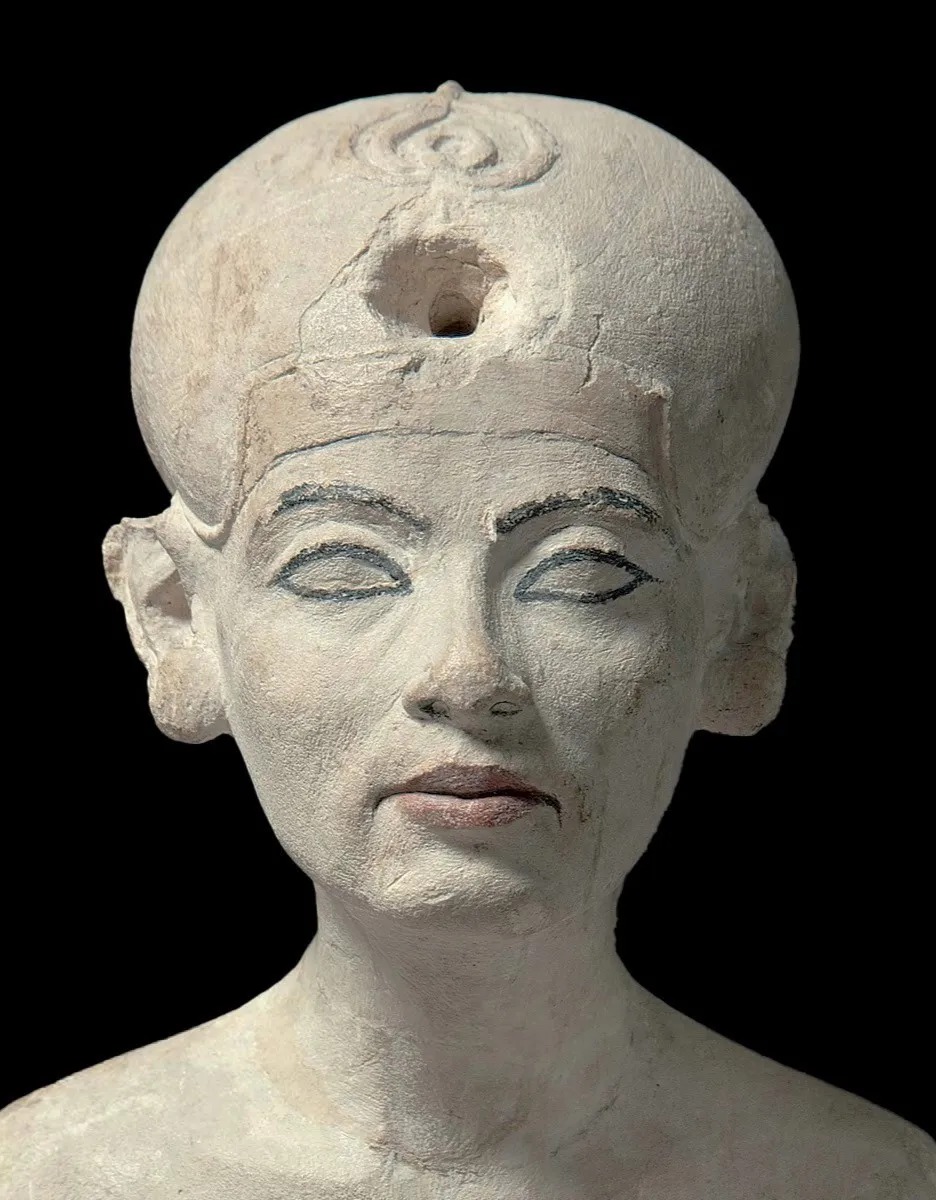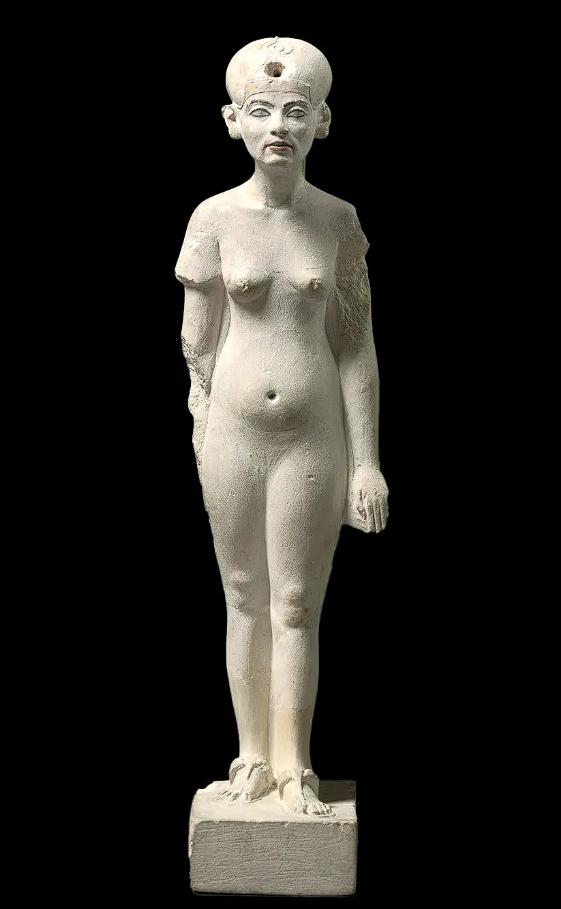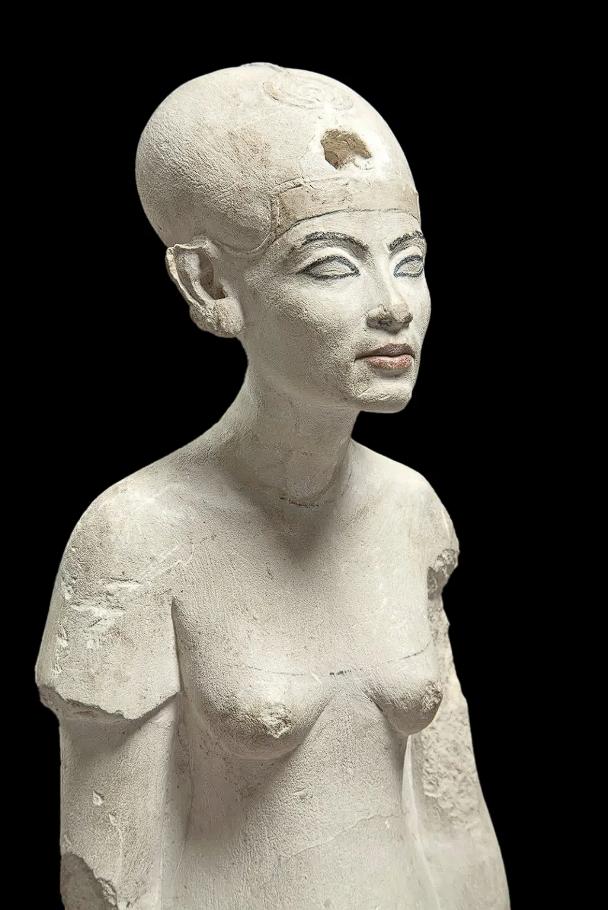The limestone striding statue of Nefertiti, unearthed from the remnants of Thutmose’s workshop in Tel el-Amarna, offers a compelling, if fragmented, window into the queen’s later years and the artistic style of the Amarna Period. This artifact, found alongside her iconic bust, sheds light on the deliberate attempts to erase her legacy while preserving the artistry that immortalized her.
A Glimpse into Nefertiti’s Later Years
The statue’s features, despite the damage, offer a unique perspective on Nefertiti in her middle age, distinct from her more idealized earlier depictions.
Subtle Signs of Aging
Egyptologists have identified subtle signs of aging in the statue, suggesting a departure from the idealized beauty often associated with Nefertiti.

- Realistic Depiction:
- The statue’s depiction of tear troughs, nasolabial folds, and deeper-set frown lines indicates a move towards a more realistic portrayal of the queen.
- It highlighted realistic depiction.
- Middle Age Representation:
- These features suggest that the statue represents Nefertiti in her middle age, offering a glimpse into how she may have appeared later in life.
- It showed middle age representation.
- Contrast to Earlier Images:
- The presence of aging signs contrasts with the more youthful and idealized representations of Nefertiti found in earlier artwork.
- It highlighted contrast to earlier images.
Damage and Defacement
The statue bears signs of deliberate damage, suggesting possible acts of defacement or plundering during the tumultuous aftermath of the Amarna Period.
- Removal of Royal Insignia:
- The absence of royal insignia suggests that the statue may have been intentionally defaced, possibly as part of the Amun priesthood’s efforts to erase Akhenaten’s and Nefertiti’s legacy.
- It highlighted removal of royal insignia.
- Damage to Nipples:
- The damage to the statue’s nipples further supports the theory of deliberate defacement, indicating a targeted attempt to damage the queen’s image.
- It showed damage to nipples.
- Possible Plundering:
- The damage may also be attributed to plundering, as the statue was found in a workshop that was likely ransacked after the abandonment of Akhetaten.
- It highlighted possible plundering.
Artistic Mastery and Enduring Legacy
Despite the damage and the passage of millennia, the statue remains a testament to the artistic mastery of the 18th Dynasty and Nefertiti’s enduring legacy.
Preserved Artistic Details
Traces of original paint and the intact face of the statue highlight the exceptional artistry of the Amarna Period.

- Remaining Paint Traces:
- The lingering traces of original paint emphasize the intricate details of the statue, such as her brows, eyelines, and lips, showcasing the vibrant colors used in ancient Egyptian art.
- It highlighted remaining paint traces.
- Intact Facial Features:
- The preserved facial features allow us to appreciate the delicate craftsmanship and the lifelike quality of the statue.
- It showed intact facial features.
- Artistic Mastery:
- The statue’s overall design and execution stand as a testament to the artistic mastery of the 18th Dynasty, a period known for its innovative and naturalistic style.
- It highlighted artistic mastery.
A Symbol of Endurance
The statue’s survival, despite the destruction of Akhetaten, ensures that Nefertiti’s legacy continues to endure.
- Testament to Survival:
- The statue’s survival through the turbulent Amarna Period and the subsequent attempts to erase its legacy highlights its enduring significance.
- It highlighted testament to survival.
- Preserving Nefertiti’s Memory:
- This artifact plays a crucial role in preserving the memory of Nefertiti, offering a tangible connection to one of ancient Egypt’s most iconic queens.
- It showed preserving Nefertiti’s memory.
- Continuing Influence:
- The statue’s existence ensures that Nefertiti’s influence continues to captivate and inspire, contributing to her enduring place in history.
- It highlighted continuing influence.
Conclusion:
The limestone striding statue of Nefertiti, with its subtle signs of aging and evidence of deliberate damage, provides a complex and nuanced portrait of the queen. It stands as a testament to the artistic mastery of the Amarna Period and the enduring legacy of Nefertiti, a figure whose beauty and influence continue to resonate across millennia.


CÁC TIN KHÁC
Mary Walton: The Forgotten Inventor Who Helped Clean Up America’s Cities
Tomb of Queen Nefertari in the Valley of the Queens, Egypt
Discover the Hypostyle Hall of the Temple of Hathor at Dendera
Venus de Losange: Unveiling the Mystery of a 20,000-Year-Old Paleolithic Icon